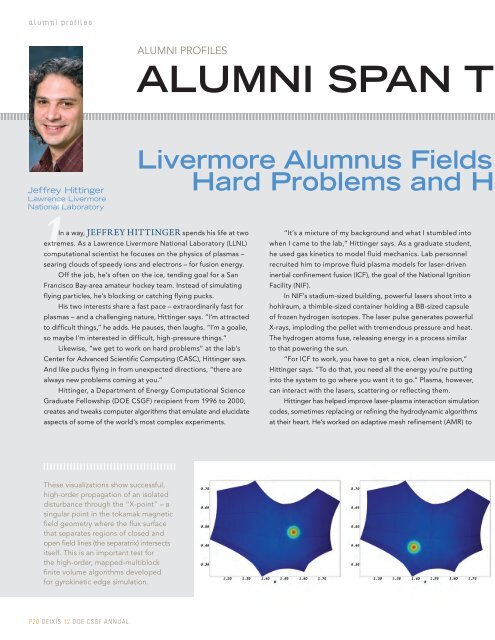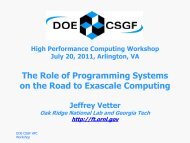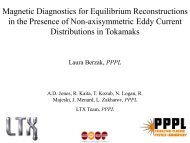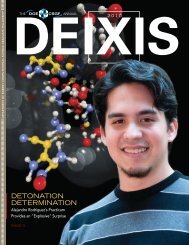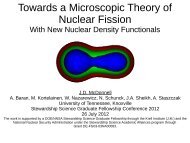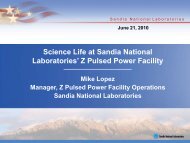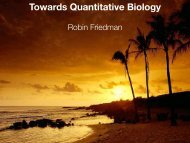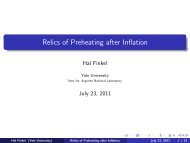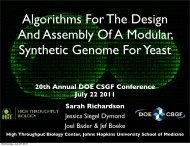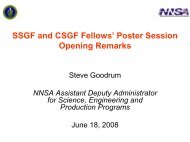2012 - Krell Institute
2012 - Krell Institute
2012 - Krell Institute
You also want an ePaper? Increase the reach of your titles
YUMPU automatically turns print PDFs into web optimized ePapers that Google loves.
ALUMNI SPAN TH<br />
alumni profiles<br />
ALUMNI PROFILES<br />
Jeffrey Hittinger<br />
Lawrence Livermore<br />
National Laboratory<br />
Livermore Alumnus Fields<br />
Hard Problems and Ho<br />
iIn a way, JEFFREY HITTINGER spends his life at two<br />
extremes. As a Lawrence Livermore National Laboratory (LLNL)<br />
computational scientist he focuses on the physics of plasmas –<br />
searing clouds of speedy ions and electrons – for fusion energy.<br />
Off the job, he’s often on the ice, tending goal for a San<br />
Francisco Bay-area amateur hockey team. Instead of simulating<br />
flying particles, he’s blocking or catching flying pucks.<br />
His two interests share a fast pace – extraordinarily fast for<br />
plasmas – and a challenging nature, Hittinger says. “I’m attracted<br />
to difficult things,” he adds. He pauses, then laughs. “I’m a goalie,<br />
so maybe I’m interested in difficult, high-pressure things.”<br />
Likewise, “we get to work on hard problems” at the lab’s<br />
Center for Advanced Scientific Computing (CASC), Hittinger says.<br />
And like pucks flying in from unexpected directions, “there are<br />
always new problems coming at you.”<br />
Hittinger, a Department of Energy Computational Science<br />
Graduate Fellowship (DOE CSGF) recipient from 1996 to 2000,<br />
creates and tweaks computer algorithms that emulate and elucidate<br />
aspects of some of the world’s most complex experiments.<br />
“It’s a mixture of my background and what I stumbled into<br />
when I came to the lab,” Hittinger says. As a graduate student,<br />
he used gas kinetics to model fluid mechanics. Lab personnel<br />
recruited him to improve fluid plasma models for laser-driven<br />
inertial confinement fusion (ICF), the goal of the National Ignition<br />
Facility (NIF).<br />
In NIF’s stadium-sized building, powerful lasers shoot into a<br />
hohlraum, a thimble-sized container holding a BB-sized capsule<br />
of frozen hydrogen isotopes. The laser pulse generates powerful<br />
X-rays, imploding the pellet with tremendous pressure and heat.<br />
The hydrogen atoms fuse, releasing energy in a process similar<br />
to that powering the sun.<br />
“For ICF to work, you have to get a nice, clean implosion,”<br />
Hittinger says. “To do that, you need all the energy you’re putting<br />
into the system to go where you want it to go.” Plasma, however,<br />
can interact with the lasers, scattering or reflecting them.<br />
Hittinger has helped improve laser-plasma interaction simulation<br />
codes, sometimes replacing or refining the hydrodynamic algorithms<br />
at their heart. He’s worked on adaptive mesh refinement (AMR) to<br />
These visualizations show successful,<br />
high-order propagation of an isolated<br />
disturbance through the “X-point” – a<br />
singular point in the tokamak magnetic<br />
field geometry where the flux surface<br />
that separates regions of closed and<br />
open field lines (the separatrix) intersects<br />
itself. This is an important test for<br />
the high-order, mapped-multiblock<br />
finite volume algorithms developed<br />
for gyrokinetic edge simulation.<br />
P20 DEIXIS 12 DOE CSGF ANNUAL


